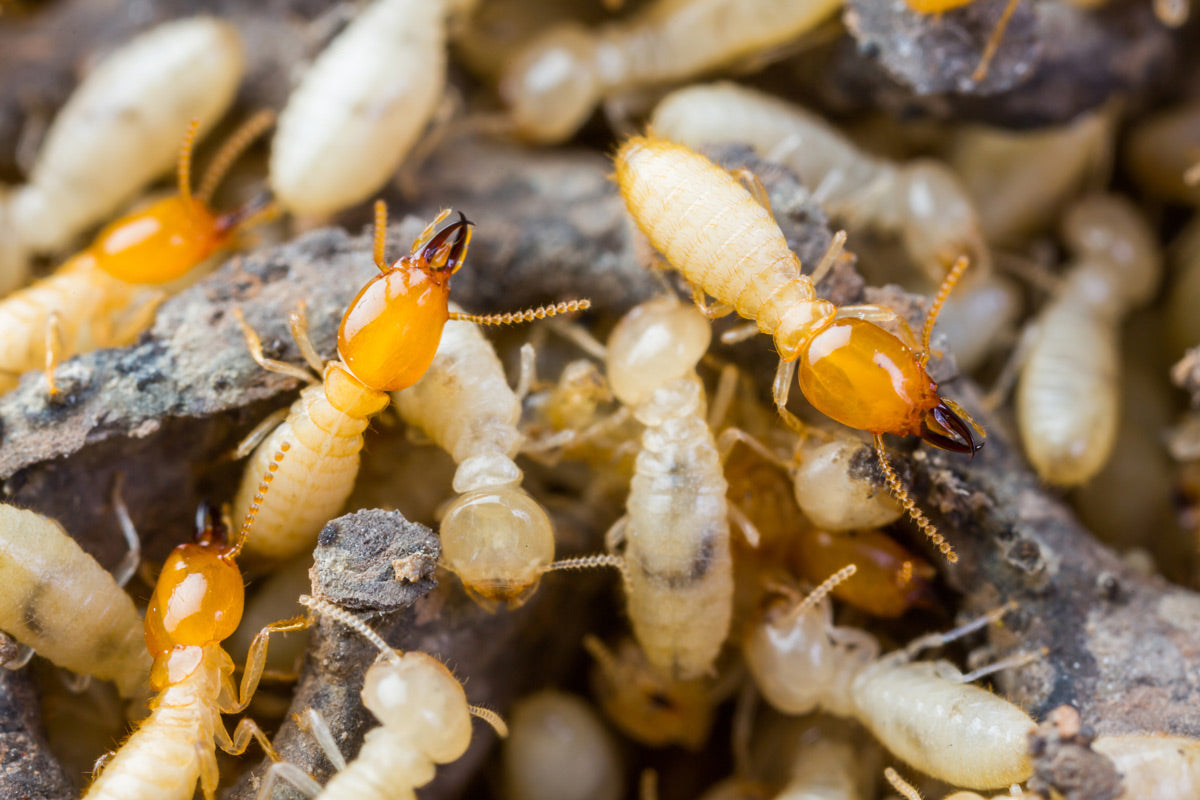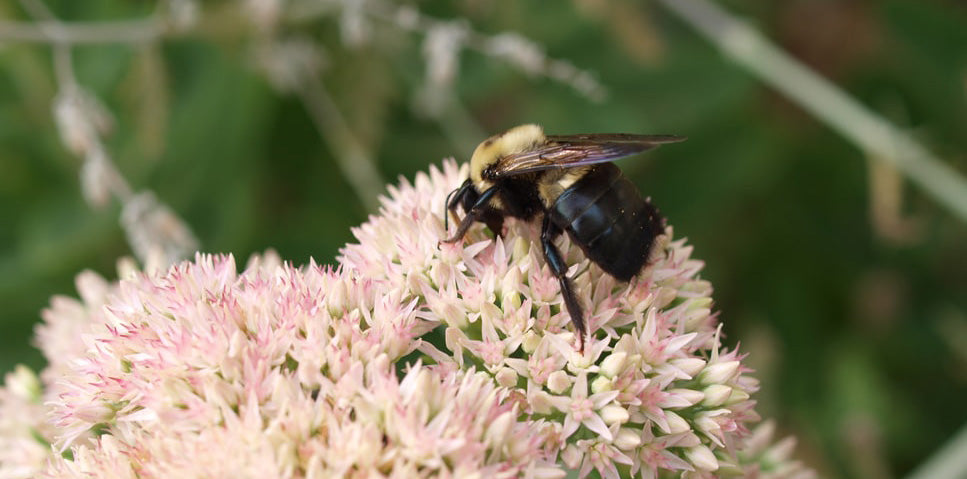Identifying and Treating Wood for Wood Eating Insects
If you’ve ever wondered which bugs leave piles of sawdust behind or which bugs eat wood, there are ways to identify these destructive pests, based on their behavior, their physical appearance, and even on the trails they leave behind. In the United States, there are three primary wood eating insects that cause structural damage.
- Termites
- Carpenter Ants
- Carpenter Bees
If you suspect you are dealing with any of these three pests, it might take some detective work to identify which wood-boring insect it is. Here are some clues that will help.
The most destructive termites are subterranean.1 This means they might enter the wood in your structure without ever being visible as they transition from the ground to wood! If you are lucky enough to see them moving about, you might first see them as swarms of winged reproductive termites, or you might only see the wings the termites shed and leave behind. If you see swarms of termites flying about in the spring, there might be a well-established colony already in your structure. If you are looking for subterranean termites, expect to find sand-like, tubular passageways that travel along walls and pipes, connecting soil and wood. The wood might sound hollow or empty when you tap on it.
When it comes to carpenter ants, there are typically more visible signs. People often see trails of large, dark ants leading into the structure. If you see the ants emerging in the spring inside, this might be a sign of a more serious infestation. If you see just a few ants, they might just be foraging, but a large number of ants, especially near windows, is a sign of trouble.
Carpenter bees can also be difficult to identify and detect. Typically the damage from carpenter bees (also known as wood boring bees) is on the outside of the structure either on unfinished wood or decking.
In general, the best way to treat wood and prevent these insects is prior to a bad infestation. You can protect your home by monitoring wood for visible holes, cracks, crevices, soft spots, and other signs of damage. You can also seal up the wood with finishes and paint to minimize access points.
Which Bugs Leave Piles of Sawdust
Unlike termites, carpenter bees and carpenter ants do not eat the wood as they burrow. Therefore, carpenter bees and carpenter ants will leave behind piles of wood particles that resemble sawdust.
How to Identify Carpenter Ants
There are six distinguishing characteristics you can use to identify carpenter ants and their damage.
- Varying Color: Carpenter ants are typically black or brown. You might also see a combination of orange and black.
- Size: Carpenter ants are not very big, but tend to be larger than termites. Expect to see them between ¼” and ½” long.
- Hourglass Shape: Carpenter ants have a round thorax, which is the segment just below the head. The midsection of the ant should be pinched and narrow in appearance. The antennae will be slightly bent. (Note: termites have straight antennae and a broader waist.)
- Wood Piles: Look for telltale wood shavings, especially below wood objects.
- Rustling Sounds: If you tap the walls in your home while pressing your ear against the wall, you might disturb the nest and hear a light rustling sound. Try listening around window frames and other areas where moisture collects.
- Nighttime Activity: Carpenter ants tend to come out at night, so check for them using a flashlight in the early morning or late night.

Termites
There are eight distinguishing characteristics to identify termites and their damage.
- Equal-Size Wings: Termites have four distinct wings that are all the same size as their bodies. Termites lose their wings after swarming, so wings are only one item to look for. (Note: ants’ wings will be different sizes.)
- Straight Antennae: Termites have two straight antennae.
- Multiple Types: There are three types of termites; winged, worker and soldier. If you see different types of insects with similar characteristics, they might all be termites.
- Small Size: Termites are generally smaller than carpenter ants at approximately ⅜” long, though they can be slightly larger than the smallest carpenter ants.
- Telltale Structural Changes: Be alert and aware of changes to your structure. For example, if your wood sounds hollow, floors are sagging or you see crumbling wood, investigate further.
- Tapping Sounds: Soldier termites often tap their heads in the walls.
- Pellet-Like Droppings: Look for tiny pellets that show up near walls or wood.
- Mud Tubes: Termites will build tubes of mud and dirt against structures to protect themselves from sun and predators. Look for these tubes around the external walls of your home.

Carpenter Bees
There are eight distinguishing characteristics to help you identify carpenter bees and their damage. Carpenter bees are most commonly mistaken for beneficial bumble bees.
- Smooth Abdomens: Look for hairless abdomens that are completely black. (Note: bumble bees will usually have fuzzy abdomen and some yellow markings.)
- No Stinger: Male carpenter bees are typically observed outside their burrows and do not have stingers. (Note: Female carpenter bees can sting.)
- No Nest Building: Carpenter bees do not build nests as honeybees or wasps do, but make their nests inside existing wood, where they burrow.
- Larger Size: Carpenter bees are slightly larger than bumble bees, but this varies by type.
- Outdoor Location: Carpenter bees are more likely to nest and be seen near areas of human activity. Look for them outside (not inside) around the eaves of houses andon decks or sheds.
- Solitary: Carpenter bees are solitary and less social than bumble bees although they are territorial during mating season.
- Aggression: Male carpenter bees cannot sting, but they are aggressive when threatened and “dive bomb” threats.
- Round Holes: Look for damage in soft unpainted woods.2 Female carpenter bees use their mandibles to make nests that appear as round holes approximately ½” in diameter. If the burrowing is active, look for wood dust on the ground.

How to Treat Your Wood for Wood Eating Insects
All three types of wood eating insects require different care to protect your structure. In general, the best defense is a good offense!
Here are some things to consider for deterring termites and carpenter ants. All of these tactics will help protect your home from both.
- Eliminate wood that comes in contact with the ground 3
- Do not allow moisture to accumulate near your home’s foundation or in crawl spaces
- Do not store firewood against your home or inside crawl spaces
- Use mulch sparingly
- Address any areas of rotten wood and seal up holes
Here are some preventive steps to take to deter carpenter bees:
- In the spring, fill in any old carpenter bee nests (½” diameter holes in exposed wood)
- Assess exposed wood, look for divots that could be the start of a nest, and also pay special attention to protected areas under overhangs or at the corners of a house
- Paint, prime and stain wood, as carpenter bees prefer untreated wood
- E.E. Grissell, Malcolm T. Sanford, and Thomas R. Fasulo, “Large Carpenter Bees,” Featured Creatures, Entomology and Nematology, University of Florida, last updated June 2014, http://entnemdept.ufl.edu/creatures/misc/bees/xylocopa.htm.
- “Carpenter Bees,” Pennsylvania State University, updated March 2, 2017, https://extension.psu.edu/carpenter-bees.
- Michael F. Potter, “ENTFACT-605: Protecting Your Home Against Termites,” College of Agriculture, University of Kentucky, accessed March 2, 2021, https://entomology.ca.uky.edu/ef605.









Leave a comment
All comments are moderated before being published.
This site is protected by hCaptcha and the hCaptcha Privacy Policy and Terms of Service apply.